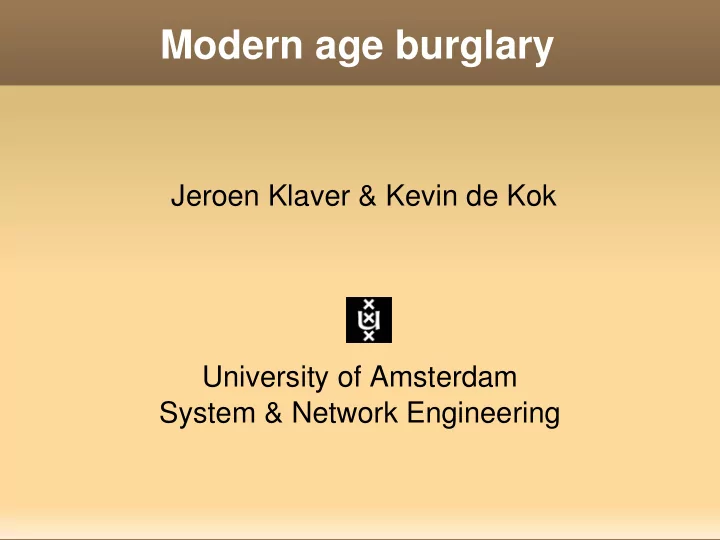

Modern age burglary Jeroen Klaver & Kevin de Kok University of Amsterdam System & Network Engineering
Outline Introduction Research question Approach Analysis Attack vectors Impact Conclusion
Introduction Old setup Alarm systems over PSTN Secure New setup Alarm systems over IP Secure?
Research question (1) Main question: ”Is it possible to perform a burglary without getting noticed by influencing the communication between the alarm system and the control room?”
Research question (2) Sub questions: Which attack vectors that targets communication can be used to bypass the alarm system? What could be the impact if alarm systems over IP- based networks are vulnerable for different attack vectors? Which improvements can be made if alarm systems over IP-based networks are vulnerable for different attack vectors?
Approach Traffic capturing part 1 Blackbox approach Getting familiarized with the data Recognising information Traffic capturing part 2 Greybox approach Different events
Network setup Hub or bridge
Traffic analysis Same packets used every time Registration Activating Deactivating Heartbeat Alarm trigger Dedicated ports used for each account Each packet is acknowledged
Packet analysis (1) Two parts Header Event specific Acknowledgement from control room Two versions No repeating pattern
Packet analysis (2) Different account code 4 digit number Two differences Specific part Header
Packet analysis (3) Specific part 4 bytes differ Encryption Hex values compared to account code XOR Key = 0xB5 UDP port number Acknowlegdement of registration packet Same encryption as account code
Packet analysis (4) Header 2 bytes differ Must be account code Example encryption Account code: 0011 Bytes: 0x00 and 0x11 XOR Key = 0x85
Think as a burglar Activate alarm on location X, deactivate from location Y. Trigger alarms from different accounts.
Attack vectors Replay attack Disable / enable alarm Trigger alarm sensors DoS (system and human) Brute force attack
Replay attack Capturing network traffic Working data sets Disabling alarm Triggering sensors
DoS attack Overloading control room with fake alarms Impact on availability security guards Requirements Data set from a real alarm Port numbers Account code Checksum
Brute force attack Control room ”coorporates” Static registration port used Account code + checksum = brute force Account code: 4 digits(0-9) == 10.000 posibilities Checksum: 1 byte == 256 posiblities Total: 10000*256 = 2.560.000 posibilites Total time needed: (2560000/2)/60/60/24) ≈ 15 days
Impact PSTN-2-IP sold by different security company's Therefore PSTN-2-IP is actively used Newer systems available: Strong encryption Seperate vpn routers QoS
Improvements Rewrite protocol Protection against replay attacks Improve confidentiality Avoid replay attacks with account information Improve integrity Avoid decrypting payload from packets Improve availability Avoid DoS possibilities
Conclusions ”Is it possible to perform a burglary without getting noticed by influencing the communication between the alarm system and the control room?” Protocol vulnerable for replay attacks No advanced crypto is used DoS A burglar needs technical knowledge and resources.
On a side note ”It takes 1,5 hours before a line failure is detected by the control room”
Questions? Report soon available at: https://www.os3.nl/2009-2010/students/kevin_de_kok/rp1
Recommend
More recommend